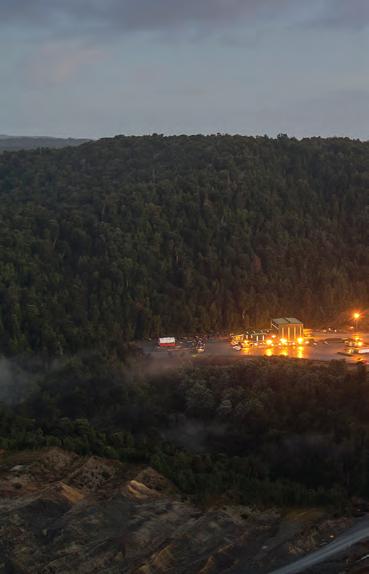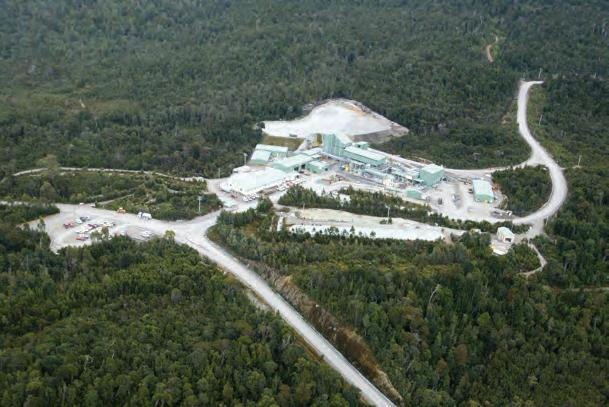
7 minute read
REGIONAL SPOTLIGHT
THE TREES AREN’T ALL THAT’S GREEN IN TASMANIA
THE FOCUS IS THROWN TO ANOTHER OF AUSTRALIA’S QUIET ACHIEVERS WHERE COLLABORATION IS KEY AND ‘NET-ZERO’ IS EFFECTIVELY A WAY OF LIFE. THE CONTRIBUTION OF TASMANIA’S MINING INDUSTRY IS WORTH FAR MORE THAN THE LAYMAN MIGHT REALISE. HENRY BALLARD WRITES.
GRANGE RESOURCES PRODUCES SOME OF THE HIGHEST QUALITY IRON ORE PELLETS.
Many people might hear Tasmania and think seafood, wine, forestry, or tourism upholds the state’s economy.
But in the 2021 financial year (FY21), Tasmania mined and processed about $2.8 billion worth of product, with $2.3 billion of that being exported. This accounted for 61 per cent of Tasmania’s exports.
In November, the state clocked a fourth consecutive month maintaining 12-month export figures above $4 billion, underpinned by mined materials and metal scraps.
The Tasmanian Minerals, Manufacturing and Energy Council (TMEC) is a membership-based organisation representing the state’s mining exploration, extraction and processing businesses, energy consumer sectors, advanced manufacturers and associated supply chains.
TMEC chief executive officer Ray Mostogl tells Australian Mining he is very optimistic for the future of the region.
“The last 12 months have been incredibly positive and all the signs are that the next 12 will also be strong,” Mostogl says.
“The drivers for the big uptake in Tasmanian mining was the rise in iron ore price, and the aluminium and zinc prices have also been favourable for our minerals sector.”
The sector has also been bolstered by some significant investment from the state government in the 2021-22 Budget.
The Exploration Drilling Grant Initiative (EDGI), for example, received $1.5 million to stimulate greenfields drilling projects, while the Geoscience Initiative received $2 million to better understand regional mineral systems.
The Budget also includes $6 million to deliver the final three years of Tasmania’s first Trade Strategy, plus $450,000 is allocated to a Diversity Action Plan to increase gender and cultural diversity in forestry and mining.
Mostogl says all this investment is welcomed by the industry as it continues to grow.
“We’ve seen a big uptick in exploration with double the number of applications in 2021 compared to 2020,” he says. “The state government has continued on with their incentive program to offset some of the costs and we’re really appreciative of that.”
But financial investment isn’t the only thing attracting people to the Tasmanian mining industry, as TMEC continues to reposition the narrative around mining with a new slogan of ‘cleaner, smarter, diverse and proud.’
This has included an extensive program in schools since the start of 2021 which Mostogl says has started to turn some attitudes around.
“We had people who just did not understand mining in Tasmania which caused us to get very active in schools,” he says.
“We’ve visited almost every high school in the last 12 months to promote the manufacturing and mining industries and raise people’s awareness of their importance to the region.”
One of the major selling points for mining in Tasmania is a state-wide claim to fame – net-zero emissions.
Tasmania has been carbon neutral in six of the past seven years thanks to its abundance of forests and an electricity grid run completely on renewable energy since 2020 – mostly hydropower and wind.
This allows mines to produce some of the greenest minerals in the world, according to Mostogl, but it’s not without its difficulties.
“We’re very fortunate to have the hydro and wind power assets to allow us to do that,” Mostogl says.
“We expect to navigate challenges involving the renewable energy sector because Tasmania has a legislated objective to become 200 per cent renewable, and some potential wind farms are located above protected mineral resources.
“Just as in New South Wales where the farming industry sometimes takes precedence over the coal mining industry, I am concerned something similar may occur in Tasmania.”
One Tasmanian miner embracing the pillars of TMEC’s campaign is Grange Resources.
Grange has operated the Savage River iron ore mine for 53 years and produced over 2.5 million tonnes of iron ore pellets in 2021.
The company’s chief operating officer Ben Maynard says his company is keen to embrace whatever technologies allow Savage River to uphold Tasmania’s green reputation.
“We’re moving into this interesting time where the world is realising its fragility over a number of issues and we’re now embracing our response to climate change,” Maynard says.
“We’re now looking at the other ways and things we can do to adapt our industry to become net-zero. As an industry, we realise we need to change and implement new technologies, so we are positioned to maintain this netzero status for the state.”
Grange takes the iron ore from Savage River and transports it 85 kilometres north to its processing facility in Port Latta on Tasmania’s

northwest coast. Here, the iron ore is turned into pellets, and as Maynard explains, it’s one of the best in the world owing to Tasmania’s unique geological composition
“We’re the most experienced magnetite producer with some really positive aspects to our pellet,” Maynard says.
“It’s got the lowest phosphorus in the world giving it very low impurities. It’s thought of as a naturally fluxed pellet and so it’s quite sought after as a premium iron ore and steelmaking input.”
To power the processing of these pellets and contribute to Tasmania’s renewable credentials, Maynard suggests some alternatives to traditional methods.
“The use of hydrogen is quite a big one the government has put some support behind,” Maynard says.
“We’ve been doing a feasibility study to understand if we can replace the use of natural gas as an energy source to create pellets at Port Latta.
“I think there’s some great aspects on the horizon there and that ‘green steel’ or ‘green minerals’ angle is another upsell for the mining industry and Tasmania as a whole.”
Miners and industry bodies alike hope that with all the community engagement and ethical operation, more workers will be encouraged to call Tasmania home.
With a range of industries operating in unison and collaboration across the west coast of Tasmania, Mostogl says making space for all businesses and employees will be key to the state’s growth.
“Part of our community

CATALYST METALS’ HENTY GOLD MINE.
engagement focusses on housing and accommodation on the west coast,” Mostogl says.
“We want to understand what the industry can do to create a network of likeminded business across industries, because there is more to the west coast than mining.
“There’s going to be a requirement for additional workers for probably the next 15 years, so we see it as an opportunity for an innovative way to set the accommodation up in a way that all these communities and industries can benefit from.”
Catalyst Metals is a far newer player than Grange in the Tasmanian mining industry, but an equally important one as the state’s only major gold producer.
The Henty gold mine began operations in 1996 and has produced 1.4 million ounces of gold since, but Catalyst took ownership of Henty in 2021 and has warmed to the region well in its first year.
“Operationally, Henty has exceeded our expectations and been very consistent,” Catalyst chief executive officer John McKinstry says.
“One of the trademarks of Henty over the last few years has been the inconsistency, but we’ve been able to really bed it down and we’ve inherited some good people as well.”
McKinstry says Catalyst is very focussed on giving back to the community in which it operates.
“What we don’t want to do is set up any kind of miner camps because it sees the miners come and go without spending any money in the town,” he says.
“We don’t want them just seeing it as a bed and room while they’re at work. Instead, our model is a better one for everyone where people miners live in the town, eat in the restaurants and buy in the shops.”
Benefitting Tasmania’s pitch for the ‘live and work’ lifestyle is the state’s handling of the COVID-19 pandemic.
At time of writing, the state has had 247 cases of the virus compared to Australia’s 250,000, and the certainty that brings for miners has had its benefits, according to McKinstry.
“We’re finding Tasmanians migrating back to Tasmania,” he says. “This is positive not only because they’re good, skilled workers but because they’ve seen first-hand how major mining communities and operations work, and they return with good standards.”
And with the right people on board, the state will be set to become an even more important piece in Australia’s mining puzzle.
In fact, Mostogl says he’s hearing that many previously unrecognised resources would come into play as Australia positions itself to become more self-serving.
“All the noise around critical minerals is that the sector is about to fire up,” Mostogl says.
“Within the Federal Government’s critical minerals portfolio, there’s a level of interest to say every state should have some sort of mineral processing capability.
“So, we see Tasmania as a potential tungsten processing facility for local and national producers.”
Yet another of the state’s niches to be developed into the future as cleaner, greener mining is recognised as vital to its growth and support. AM











